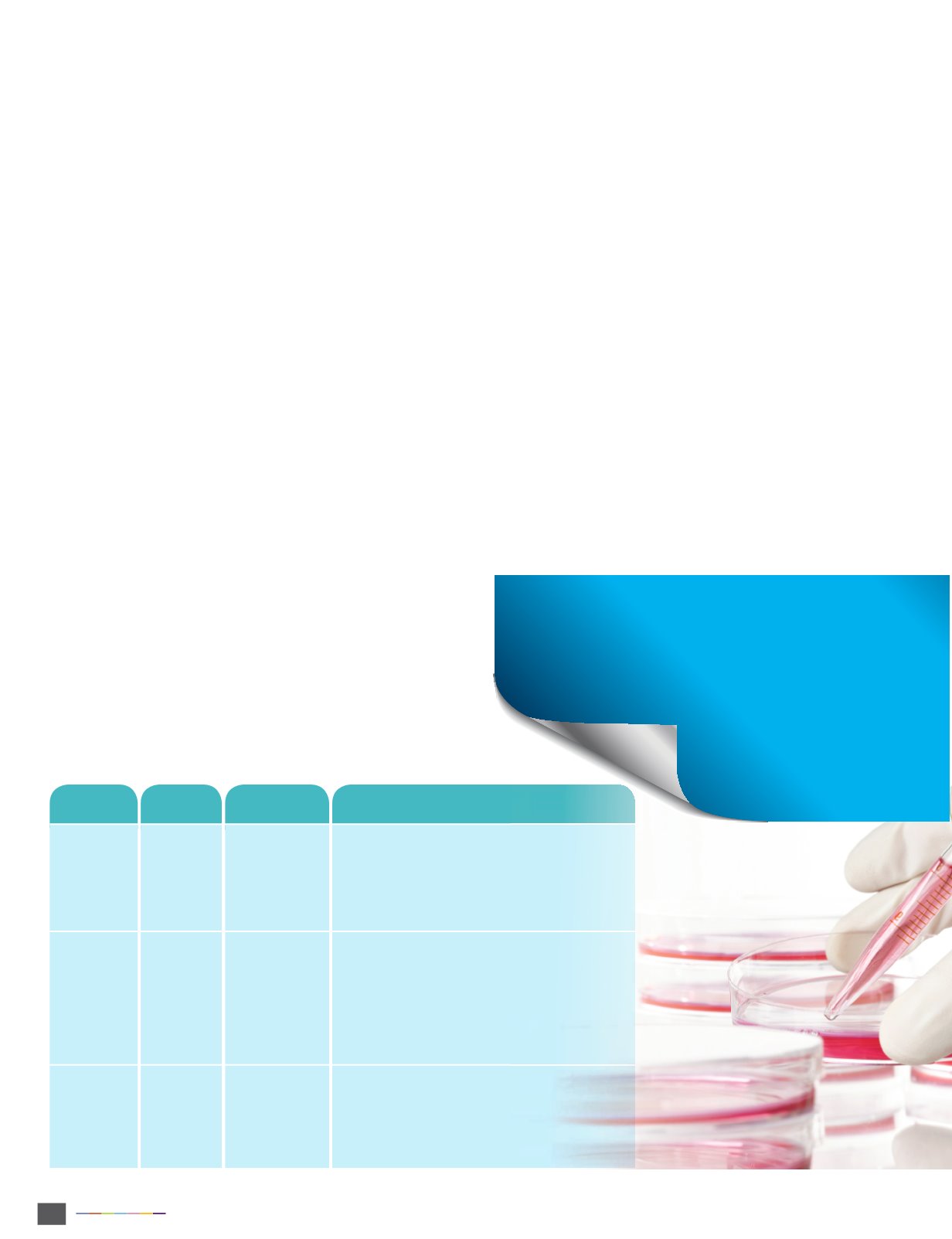
Food Focus Thailand
AUGUST 2013
34
Hue
แต
ละแห
ง ตั
วอย
าง เช
น ข
อกำหนดมาตรฐานของกุ
งแช
เยื
อกแข็
ง (Standard
for frozen prawns) ได
แก
• TVC ต่
ำกว
า 10
6
ต
อกรั
ม
• โคลิ
ฟอร
ม ต่
ำกว
า 10
2
ต
อกรั
ม
•
Staphylococcus aureus
ต่
ำกว
า 10 ต
อกรั
ม
• ไม
พบ
Salmonella
จากมาตรฐานดั
งกล
าวจะสั
งเกตว
ายั
งไม
มี
การระบุ
เกี่
ยวกั
บขนาดหรื
อ
ปริ
มาณของตั
วอย
างที่
จะต
องนำมาใช
วิ
เคราะห
ต
อมาในป
พ.ศ. 2505
International Commission on the Microbiological Specifications for
Foods (ICMSF) ได
ก
อตั้
งขึ้
น และป
พ.ศ. 2517 องค
กรได
เสนอข
อกำหนด
ของอาหารที่
ครอบคลุ
มอาหารและผลิ
ตภั
ณฑ
ประเภทต
างๆ ซึ่
งครอบคลุ
ม
ส
วนผสม (Ingredients) ที่
ใช
กั
บอาหาร และในป
พ.ศ. 2518 มี
การก
อตั้
ง
คณะกรรมการร
วม FAO/WHO เพื่
อกำหนดมาตรฐานอาหารทางจุ
ลชี
ววิ
ทยา
โดยข
อกำหนดมาตรฐานดั
งกล
าวนิ
ยมใช
อย
างแพร
หลายในอุ
ตสาหกรรมอาหาร
รวมทั้
งในองค
กรต
างๆ ระดั
บชาติ
และนานาชาติ
ข
อมู
ลที่
ใช
ในการกำหนดเกณฑ
มาตรฐานอาหาร
ในการกำหนดเกณฑ
มาตรฐานอาหารชนิ
ดต
างๆ จะต
องนำข
อมู
ลต
างๆ
มาพิ
จารณาเพื่
อสร
างข
อกำหนด เช
น ข
อมู
ลทางระบาดวิ
ทยา ระดั
บหรื
อปริ
มาณ
ของจุ
ลิ
นทรี
ย
ที่
ทำให
อาหารและผลิ
ตภั
ณฑ
เกิ
ดการเสื่
อมเสี
ย ระดั
บการปนเป
อน
ของจุ
ลิ
นทรี
ย
ที่
ยอมรั
บได
ภายใต
สภาวะการผลิ
ตตามหลั
กปฏิ
บั
ติ
ที่
ดี
ในการผลิ
ต
(Good Manufacturing Practice; GMP) ระยะเวลาอาหารที่
ใช
ในการเจริ
ญ
เติ
บโตของจุ
ลิ
นทรี
ย
หรื
อการรอดชี
วิ
ตของจุ
ลิ
นทรี
ย
ก
อโรค และการเจริ
ญของ
จุ
ลิ
นทรี
ย
ขณะเก็
บรั
กษาอาหาร ระหว
างการผลิ
ต ขณะกระจายสิ
นค
า หรื
อ
จำหน
ายสิ
นค
า จุ
ดและสาเหตุ
ที่
มี
การปนเป
อนของจุ
ลิ
นทรี
ย
ระหว
างการผลิ
ต
อาหาร การกระจายสิ
นค
าและขณะจำหน
าย ลั
กษณะการบริ
โภคอาหารของ
ผู
บริ
โภค กลุ
มผู
บริ
โภคที่
เป
นเป
าหมายของสิ
นค
าและวิ
ธี
การ รวมทั้
งความ-
น
าเชื่
อถื
อและความเที่
ยงตรงของวิ
ธี
ที่
ใช
ตรวจวิ
เคราะห
อาหาร
Food Microbiological Requirement
Food Microbiological Requirement is there to be used as reference
criteria for microbiological quality assurance of food, which is used as
a measure to protect consumers from danger of microbe or toxin from
microbe, and in order to enable food to have sufficient shelf-life until it
reaches consumer’s hand. Furthermore, it also indicates hygiene in food
production of producer as well. For the producer, food microbiological
requirement will be used in case of a dispute from product rejection
from customer, or from other companies, including from international
organization, and marketing status relating to product confidence from
epidemic due to food poisoning.
Food requirement started to be used from since 1950, to be used for
import/export. This triggers high quality of distribution, which is harmless
to consumer. In the first stage, there was still no microbiological detailed
requirement in each product, including sampling and analysis techniques
of each location are different such as standard for frozen prawns, i.e.;
• TVC below 10
6
per gram
• Coliform below10
2
per gram
•
Staphylococcus aureus
below 10 per gram
• No
Salmonella
From such standard, it can be noticed that there is no specification
relating to size and quantity of sample that is required to be analyzed.
Later, in 1962, International Commission on the Microbiological
Specifications for Foods (ICMSF) was established, and in 1974, the
organization recommended requirement of food covering various types
of food and products, which includes ingredients and in 1975, a joint
commission, FAO/WHO was established to determine microbiological
food standard, which such standard requirement is widely used in food
industry, as well as in national and international organizations.
ตารางที่
1
ผลการวิ
เคราะห
กุ
งสุ
กชุ
บแป
งทอด/Result of Crispy Deep-Fried Prawn Analysis
การผลิ
ต /
Production
ตั
วอย
าง /
Sample
ปริ
มาณเชื้
อ /
Colony (cfu/g)
สรุ
ปผล/Summary
1
2
3
1
2
3
4
5
1
2
3
4
5
1
2
3
4
5
4.0 x 10
4
3.2 x 10
5
4.2 x 10
5
9.6 x 10
4
4.9 x 10
5
6.3 x 10
6
4.8 x 10
5
2.1 x 10
5
5.9 x 10
5
3.6 x 10
5
3.2 x 10
5
7.8 x 10
7
4.8 x 10
5
1.3 x 10
5
4.9 x 10
4
ที่
มา/Source: Garbutt (1997)
ทุ
กตั
วอย
างมี
ค
าต่
ำกว
า m การผลิ
ตนี้
ได
รั
บการยอมรั
บ/
Every sample has value lower than m, this
production is accepted.
มี
2 ตั
วอย
างที่
มี
ค
าอยู
ระหว
าง m และ M ส
วนตั
วอย
าง
อื่
นๆ มี
ค
าต่
ำกว
า m แต
ค
า c = 2 ดั
งนั้
น การผลิ
ตนี้
ได
รั
บ
การยอมรั
บ/ There are two samples with value
between m and M, while other samples have value
lower than m. Due to c = 2, therefore, this
production is accepted.
มี
1 ตั
วอย
างที่
มี
ค
าสู
งกว
า M ดั
งนั้
น การผลิ
ตนี้
ไม
ได
รั
บการ
ยอมรั
บ/ There is one sample with value higher than
M, therefore, this production is un accepted.
ชนิ
ดของจุ
ลิ
นทรี
ย
แบ
งตามระดั
บความรุ
นแรงในการก
อโรค/
Types of microbes divided according to danger level
ระดั
บความรุ
นแรง:
อั
นตราย /
Level:
Severe disease
จุ
ลิ
นทรี
ย
/Microorganism:
Clostridium botulinum, Salmonella
typhi, Salmonella paratyphi, Salmonella choleraesuis, Shigella
dysenteriae, Brucella melitensis, Clostridium perfringens type C,
Mycobacterium tuberculosis (M. bovis), Vibrio cholerae,
Infections hepatitis virus A
ที่
มา/Source: Garbutt (1997)


